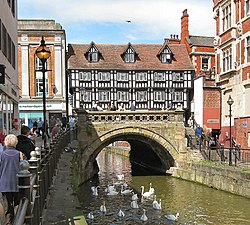High Bridge, Lincoln
High Bridge | |
|---|---|
 | |
| Coordinates | 53°13′42.7″N 0°32′26.4″W / 53.228528°N 0.540667°W |
| Carries | Lincoln High Street |
| Crosses | River Witham |
| Locale | Lincoln, England |
| Heritage status | Grade I listed building |
| Characteristics | |
| Material | Stone |
| History | |
| Opened | 1160 |
| Location | |
 | |
High Bridge, also known as the Glory Hole, carries the High Street across the
History
The bridge was built around 1160.[3] The ribs of the original bridge survive, making it possibly the second-oldest masonry arch bridge in Britain and certainly the oldest with intact buildings on it. Churches and other ecclesiastical buildings were not uncommon on or near medieval bridges but High Bridge is unusual in carrying a secular building.[4]
The current row of
Bridges like this were common in the Middle Ages, the best known being London Bridge, but most have long since been demolished because of their obstruction to the river flow and to shipping.

The Glory Hole is the name given by generations of boaters to the High Bridge in
Since the 14th century, the bridge has contributed to floods in Lincoln and after any heavy rain the bridge is virtually unnavigable to boats, which may be why it got its name.[clarification needed] A design by William Jessop in the 19th century to reroute the waters of the Witham through the south of the town was never implemented.
The bridge is both a grade I listed building[10] and a scheduled monument.[11]
For centuries the main thoroughfare through Lincoln was the High Street and all traffic had to cross High Bridge. A bypass was built in 1971, taking traffic away from the city centre, and the High Street, including the bridge, was pedestrianised.[4]
Design
The bridge has a single
The bridge chapel, built on the bridge in 1235, fell into disuse in 1549 as a result of the English Reformation. It was demolished in 1762 and a stone obelisk was built on its site as a conduit. The obelisk was removed in 1939 as it impeded traffic across the bridge.[4]
See also
References
Bibliography
- Barton, Barry (2016). Civil Engineering Heritage: East Midlands. Lincoln: Ruddock's. ISBN 9780904327243.
Footnotes
- ^ Trapped boat rescued from Lincoln's historic Glory Hole. BBC News. 28 November 2023. Retrieved 3 December 2023.
- ^ "High Bridge". City of Lincoln Council. Archived from the original on 27 September 2011. Retrieved 22 March 2011.
- ^ High Bridge and the Glory Hole, Lincoln. Britain Express. Retrieved 3 December 2023.
- ^ a b c d Barton, p. 99.
- ^ "Stokes Tea & Coffee Website". Stokes Tea & Coffee. 29 September 2018. Retrieved 14 September 2023.
- ^ Antram N. (revised), Pevsner N. & Harris J., (1989), The Buildings of England: Lincolnshire, Yale University Press, p. 523
- ^ "Lincoln". Retrieved 22 March 2011.
- ^ Emergency repairs at Lincoln Glory Hole. Lincolnshire County Council. 20 February 2023. Retrieved 3 December 2023.
- ^ High Bridge. Visit Lincoln. Retrieved 3 December 2023.
- ^ Historic England. "High Bridge (1388574)". National Heritage List for England. Retrieved 22 January 2019.
- ^ Historic England. "High Bridge, Lincoln (1005030)". National Heritage List for England. Retrieved 22 January 2019.
